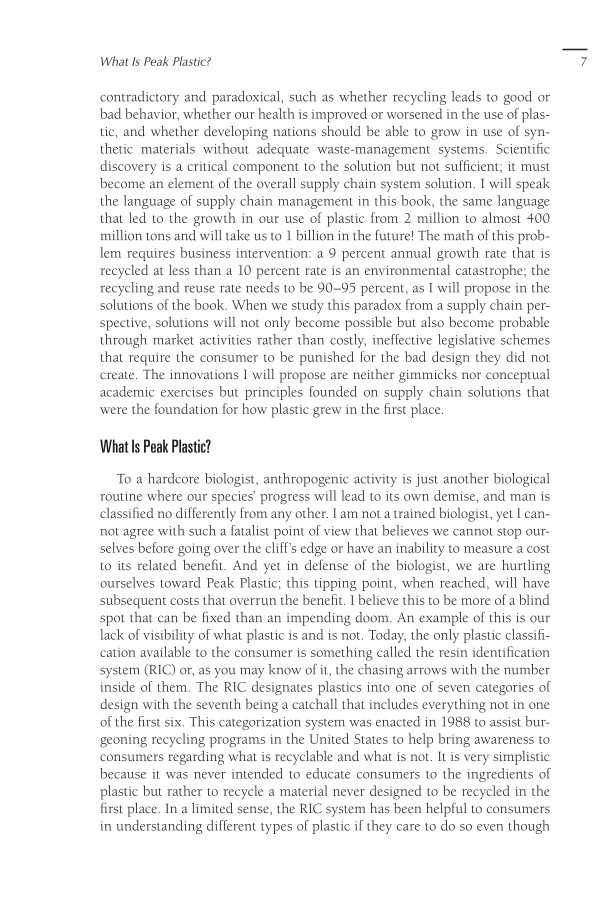What Is Peak Plastic? 7 contradictory and paradoxical, such as whether recycling leads to good or bad behavior, whether our health is improved or worsened in the use of plas- tic, and whether developing nations should be able to grow in use of syn- thetic materials without adequate waste-management systems. Scientific discovery is a critical component to the solution but not sufficient it must become an element of the overall supply chain system solution. I will speak the language of supply chain management in this book, the same language that led to the growth in our use of plastic from 2 million to almost 400 million tons and will take us to 1 billion in the future! The math of this prob- lem requires business intervention: a 9 percent annual growth rate that is recycled at less than a 10 percent rate is an environmental catastrophe the recycling and reuse rate needs to be 90–95 percent, as I will propose in the solutions of the book. When we study this paradox from a supply chain per- spective, solutions will not only become possible but also become probable through market activities rather than costly, ineffective legislative schemes that require the consumer to be punished for the bad design they did not create. The innovations I will propose are neither gimmicks nor conceptual academic exercises but principles founded on supply chain solutions that were the foundation for how plastic grew in the first place. What Is Peak Plastic? To a hardcore biologist, anthropogenic activity is just another biological routine where our species’ progress will lead to its own demise, and man is classified no differently from any other. I am not a trained biologist, yet I can- not agree with such a fatalist point of view that believes we cannot stop our- selves before going over the cliff’s edge or have an inability to measure a cost to its related benefit. And yet in defense of the biologist, we are hurtling ourselves toward Peak Plastic this tipping point, when reached, will have subsequent costs that overrun the benefit. I believe this to be more of a blind spot that can be fixed than an impending doom. An example of this is our lack of visibility of what plastic is and is not. Today, the only plastic classifi- cation available to the consumer is something called the resin identification system (RIC) or, as you may know of it, the chasing arrows with the number inside of them. The RIC designates plastics into one of seven categories of design with the seventh being a catchall that includes everything not in one of the first six. This categorization system was enacted in 1988 to assist bur- geoning recycling programs in the United States to help bring awareness to consumers regarding what is recyclable and what is not. It is very simplistic because it was never intended to educate consumers to the ingredients of plastic but rather to recycle a material never designed to be recycled in the first place. In a limited sense, the RIC system has been helpful to consumers in understanding different types of plastic if they care to do so even though
Document Details My Account Print multiple pages
Print
You have printed 0 times in the last 24 hours.
Your print count will reset on at .
You may print 0 more time(s) before then.
You may print a maximum of 0 pages at a time.
































































































































































